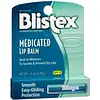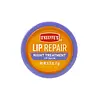What's inside
What's inside
 Key Ingredients
Key Ingredients

 Benefits
Benefits

No benefits
 Concerns
Concerns

 Ingredients Side-by-side
Ingredients Side-by-side

Dimethicone 2%
EmollientEthylhexyl Methoxycinnamate 6.6%
UV AbsorberEthylhexyl Salicylate 4.4%
UV AbsorberBeeswax
Emulsion StabilisingCamphor
MaskingCetyl Alcohol
EmollientCetyl Palmitate
EmollientEuphorbia Cerifera Wax
Aroma
Isopropyl Myristate
EmollientLanolin
EmollientLanolin Oil
EmollientMenthol
MaskingMethyl Salicylate
PerfumingParaffinum Liquidum
EmollientOzokerite
Emulsion StabilisingParaffin
PerfumingPetrolatum
EmollientPhenoxyethanol
PreservativePolybutene
CI 15850
Cosmetic ColorantTheobroma Cacao Seed Butter
EmollientTitanium Dioxide
Cosmetic ColorantDimethicone 2%, Ethylhexyl Methoxycinnamate 6.6%, Ethylhexyl Salicylate 4.4%, Beeswax, Camphor, Cetyl Alcohol, Cetyl Palmitate, Euphorbia Cerifera Wax, Aroma, Isopropyl Myristate, Lanolin, Lanolin Oil, Menthol, Methyl Salicylate, Paraffinum Liquidum, Ozokerite, Paraffin, Petrolatum, Phenoxyethanol, Polybutene, CI 15850, Theobroma Cacao Seed Butter, Titanium Dioxide
Dimethicone
EmollientBeeswax
Emulsion StabilisingPetrolatum
EmollientButyrospermum Parkii Butter
Skin ConditioningPrunus Amygdalus Dulcis Oil
Skin ConditioningHydrogenated Poly(C6-14 Olefin)
EmollientTrimethylpentanediol/Adipic Acid/Glycerin Crosspolymer
Skin ConditioningPolysilicone-11
Simmondsia Chinensis Seed Oil
EmollientHydrogenated Vegetable Oil
EmollientDipentaerythrityl Tetrabehenate/Polyhydroxystearate
HumectantIsostearyl Lactate
EmollientCalophyllum Tacamahaca Seed Oil
EmollientOrbignya Oleifera Seed Oil
EmollientTocopheryl Acetate
AntioxidantCocos Nucifera Oil
MaskingTheobroma Grandiflorum Seed Butter
Skin ConditioningAstrocaryum Murumuru Seed Butter
EmollientAroma
Gardenia Taitensis Flower Extract
Skin ConditioningC30-45 Alkyldimethylsilyl Polypropylsilsesquioxane
Ethylene/Propylene/Styrene Copolymer
Butylene/Ethylene/Styrene Copolymer
Pentaerythrityl Tetra-Di-T-Butyl Hydroxyhydrocinnamate
AntioxidantDimethicone, Beeswax, Petrolatum, Butyrospermum Parkii Butter, Prunus Amygdalus Dulcis Oil, Hydrogenated Poly(C6-14 Olefin), Trimethylpentanediol/Adipic Acid/Glycerin Crosspolymer, Polysilicone-11, Simmondsia Chinensis Seed Oil, Hydrogenated Vegetable Oil, Dipentaerythrityl Tetrabehenate/Polyhydroxystearate, Isostearyl Lactate, Calophyllum Tacamahaca Seed Oil, Orbignya Oleifera Seed Oil, Tocopheryl Acetate, Cocos Nucifera Oil, Theobroma Grandiflorum Seed Butter, Astrocaryum Murumuru Seed Butter, Aroma, Gardenia Taitensis Flower Extract, C30-45 Alkyldimethylsilyl Polypropylsilsesquioxane, Ethylene/Propylene/Styrene Copolymer, Butylene/Ethylene/Styrene Copolymer, Pentaerythrityl Tetra-Di-T-Butyl Hydroxyhydrocinnamate
 Reviews
Reviews

Ingredients Explained
These ingredients are found in both products.
Ingredients higher up in an ingredient list are typically present in a larger amount.
Aroma refers to an ingredient, or mixture of ingredients, that impart or mask a flavor.
The name is slightly confusing. This is because INCI associates aroma with flavor instead of smell.
Here is the official definition from the The International Cosmetic Ingredient Dictionary and Handbook:
“Aroma is a term for ingredient labeling used to identify that a product contains a material or combination of materials normally added to a cosmetic to produce or to mask a particular flavor.”
INCI shows the only purpose of aroma to be "flavouring".
However, due to regulation differences, some companies may use aroma in place of parfum.
In Canada, this ingredient only has to be listed in concentrations above 1%.
Learn more about AromaBeeswax is natural wax produced by honey bees and can be synthetically created. It consists mainly of fatty acid esters and long-chain alcohols.
In cosmetics, beeswax is a emollient. Due to its waxy structure, it creates a protective barrier. This barrier prevents water from evaporating off the skin.
This may not be a good ingredient for oily skin. We recommend speaking with a professional if you have concerns.
Beeswax cannot be removed with water, but can be taken off with an oil cleanser.
Beeswax is also antiseptic and contains vitamin A.
Learn more about BeeswaxDimethicone is a type of synthetic silicone created from natural materials such as quartz.
What it does:
Dimethicone comes in different viscosities:
Depending on the viscosity, dimethicone has different properties.
Ingredients lists don't always show which type is used, so we recommend reaching out to the brand if you have questions about the viscosity.
This ingredient is unlikely to cause irritation because it does not get absorbed into skin. However, people with silicone allergies should be careful about using this ingredient.
Note: Dimethicone may contribute to pilling. This is because it is not oil or water soluble, so pilling may occur when layered with products. When mixed with heavy oils in a formula, the outcome is also quite greasy.
Learn more about DimethiconePetrolatum is more commonly known as petroleum jelly. It is created by mixing waxes and mineral oils.
This ingredient is effective at reducing water loss by 99%. This is because it is an occlusive. Occlusives create a hydrophobic barrier on the skin to prevent evaporation. This property makes it great for hydrating dry skin.
Pro tip: Use occlusives, such as this ingredient, on damp skin for the best results.
The quality or origin of petrolatum is only known when disclosed by the brand. Most cosmetic petrolatum has gone through several purification stages.
Another benefit of occlusives is it protects your skin against infection or allergies.
Petrolatum may not be safe for fungal-acne. Studies show mineral oil / petroleum leads to the growth of M. Furfur, a type of yeast.
Learn more about Petrolatum